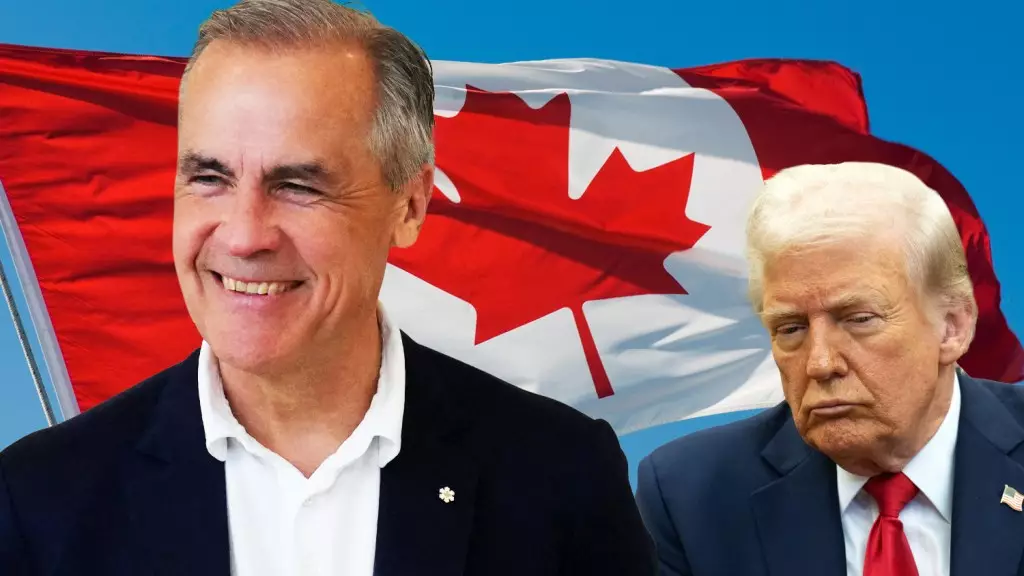In an astounding political turnaround, Canada’s Liberal Party has successfully clutched a minority government, defying pre-election expectations that suggested an impending defeat. Under the leadership of Mark Carney, the former head of both the Bank of Canada and the Bank of England, the party has demonstrated resilience against a backdrop of political turbulence and foreign challenges. The Liberals, once thought to be on the verge of collapse during Justin Trudeau’s tenure, have emerged with renewed vigor. This comeback, reminiscent of a phoenix rising from ashes, showcases the shifting tides of Canadian politics and the dynamic interplay between national sentiment and political leadership.
The Significance of Tariffs and Trump’s Shadow
The political landscape in Canada has been heavily influenced by external forces, most notably the tariffs imposed by former U.S. President Donald Trump. These tariffs ignited a wave of patriotism among Canadians, as they were perceived not only as economic barriers but also as assaults on national sovereignty. Carney seized upon the rampant dissatisfaction stemming from these challenges, positioning the Liberal Party as a bulwark against Trump’s whims. In a climate where Canadian identity was increasingly at stake, this strategy proved pivotal in rallying support and crystallizing opposition to Conservative leader Pierre Poilievre, who attempted to emulate Trump’s populist style.
While the Liberals managed to maintain their foothold in a deeply polarized political environment, this outcome is indicative of a broader trend: Canadians’ growing aversion to divisive rhetoric and a yearning for stability over volatility. Carney’s focus on Canada’s economic independence, paired with a commitment to countering foreign interventions, resonated with an electorate weary of the uncertainties wrought by the Trump administration.
Election Day: Mourning and Momentum
The election was held on a day shadowed by tragedy, following a horrific incident in Vancouver where lives were lost at a street festival. Such a dark backdrop underscored the collective psyche of the nation, amplifying the emotional stakes of the election. The juxtaposition of grief and civic duty is a poignant reminder of the weight political decisions carry over the lives of everyday citizens. Voters headed to the polls with a heavy heart, yet there was a palpable sense of urgency to reclaim agency through their votes.
In the early hours of the evening, results began to trickle in, suggesting a tighter race than anticipated. The Liberals’ performance in pivotal regions like Ontario and Quebec signaled that Canadians had made a choice to reinforce their government just when they needed continuity the most. It was not merely a win for the Liberals; it was a testament to the electorate’s desire to forge a clear identity amidst chaos.
A Two-Party Parliament Emerges
Interestingly, the election results unveiled a landscape where smaller parties were all but marginalized, leading to a rare two-party dynamic within the Canadian Parliament. The Liberals secured 147 seats against the Conservatives’ 104, highlighting a seismic shift in party allegiance and voter engagement. A drive toward a more binary political setup had emerged, leaving the other parties scrambling for relevance.
The implications of such a shift are far-reaching. Canadians may find themselves more politically polarized, but at the same time, this could stimulate a resurgence in political discourse and engagement as parties scrabble to reclaim their footing. What remains to be seen is how the Liberals will leverage this opportunity to foster a legislative agenda that meets the needs of a diverse electorate while guarding against the baseline trend of polarization.
The Road Ahead for Carney and the Liberals
Mark Carney’s ascendance to the prime ministership signals an exciting phase in Canadian politics, filled with potential for innovative economic policies and redefined foreign relations. With the Liberals now poised to possibly pursue their first majority since 2019, Carney faces the dual challenge of unifying his party and pacifying discontent among potential detractors. The electoral victory, while a moment of triumph, is merely the starting line for the hard work ahead.
In navigating these waters, it remains essential for Carney and his team to maintain a clear narrative that adheres to its commitment to Canadian sovereignty while fostering economic growth. The stakes are high, and the landscape is increasingly competitive; the future of the Liberal Party—and indeed, the fabric of Canadian governance—hangs in the balance as this era unfolds.

